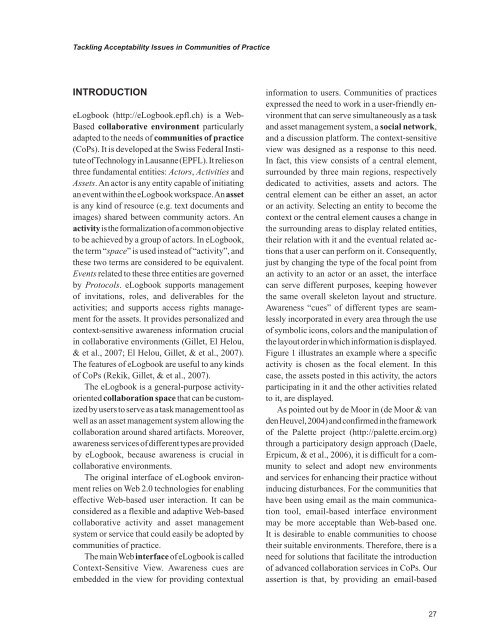Web-based Learning Solutions for Communities of Practice
Web-based Learning Solutions for Communities of Practice
Web-based Learning Solutions for Communities of Practice
You also want an ePaper? Increase the reach of your titles
YUMPU automatically turns print PDFs into web optimized ePapers that Google loves.
Tackling Acceptability Issues in <strong>Communities</strong> <strong>of</strong> <strong>Practice</strong><br />
INTRODUCTION<br />
eLogbook (http://eLogbook.epfl.ch) is a <strong>Web</strong>-<br />
Based collaborative environment particularly<br />
adapted to the needs <strong>of</strong> communities <strong>of</strong> practice<br />
(CoPs). It is developed at the Swiss Federal Institute<br />
<strong>of</strong> Technology in Lausanne (EPFL). It relies on<br />
three fundamental entities: Actors, Activities and<br />
Assets. An actor is any entity capable <strong>of</strong> initiating<br />
an event within the eLogbook workspace. An asset<br />
is any kind <strong>of</strong> resource (e.g. text documents and<br />
images) shared between community actors. An<br />
activity is the <strong>for</strong>malization <strong>of</strong> a common objective<br />
to be achieved by a group <strong>of</strong> actors. In eLogbook,<br />
the term “space” is used instead <strong>of</strong> “activity”, and<br />
these two terms are considered to be equivalent.<br />
Events related to these three entities are governed<br />
by Protocols. eLogbook supports management<br />
<strong>of</strong> invitations, roles, and deliverables <strong>for</strong> the<br />
activities; and supports access rights management<br />
<strong>for</strong> the assets. It provides personalized and<br />
context-sensitive awareness in<strong>for</strong>mation crucial<br />
in collaborative environments (Gillet, El Helou,<br />
& et al., 2007; El Helou, Gillet, & et al., 2007).<br />
The features <strong>of</strong> eLogbook are useful to any kinds<br />
<strong>of</strong> CoPs (Rekik, Gillet, & et al., 2007).<br />
The eLogbook is a general-purpose activityoriented<br />
collaboration space that can be customized<br />
by users to serve as a task management tool as<br />
well as an asset management system allowing the<br />
collaboration around shared artifacts. Moreover,<br />
awareness services <strong>of</strong> different types are provided<br />
by eLogbook, because awareness is crucial in<br />
collaborative environments.<br />
The original interface <strong>of</strong> eLogbook environment<br />
relies on <strong>Web</strong> 2.0 technologies <strong>for</strong> enabling<br />
effective <strong>Web</strong>-<strong>based</strong> user interaction. It can be<br />
considered as a flexible and adaptive <strong>Web</strong>-<strong>based</strong><br />
collaborative activity and asset management<br />
system or service that could easily be adopted by<br />
communities <strong>of</strong> practice.<br />
The main <strong>Web</strong> interface <strong>of</strong> eLogbook is called<br />
Context-Sensitive View. Awareness cues are<br />
embedded in the view <strong>for</strong> providing contextual<br />
in<strong>for</strong>mation to users. <strong>Communities</strong> <strong>of</strong> practices<br />
expressed the need to work in a user-friendly environment<br />
that can serve simultaneously as a task<br />
and asset management system, a social network,<br />
and a discussion plat<strong>for</strong>m. The context-sensitive<br />
view was designed as a response to this need.<br />
In fact, this view consists <strong>of</strong> a central element,<br />
surrounded by three main regions, respectively<br />
dedicated to activities, assets and actors. The<br />
central element can be either an asset, an actor<br />
or an activity. Selecting an entity to become the<br />
context or the central element causes a change in<br />
the surrounding areas to display related entities,<br />
their relation with it and the eventual related actions<br />
that a user can per<strong>for</strong>m on it. Consequently,<br />
just by changing the type <strong>of</strong> the focal point from<br />
an activity to an actor or an asset, the interface<br />
can serve different purposes, keeping however<br />
the same overall skeleton layout and structure.<br />
Awareness “cues” <strong>of</strong> different types are seamlessly<br />
incorporated in every area through the use<br />
<strong>of</strong> symbolic icons, colors and the manipulation <strong>of</strong><br />
the layout order in which in<strong>for</strong>mation is displayed.<br />
Figure 1 illustrates an example where a specific<br />
activity is chosen as the focal element. In this<br />
case, the assets posted in this activity, the actors<br />
participating in it and the other activities related<br />
to it, are displayed.<br />
As pointed out by de Moor in (de Moor & van<br />
den Heuvel, 2004) and confirmed in the framework<br />
<strong>of</strong> the Palette project (http://palette.ercim.org)<br />
through a participatory design approach (Daele,<br />
Erpicum, & et al., 2006), it is difficult <strong>for</strong> a community<br />
to select and adopt new environments<br />
and services <strong>for</strong> enhancing their practice without<br />
inducing disturbances. For the communities that<br />
have been using email as the main communication<br />
tool, email-<strong>based</strong> interface environment<br />
may be more acceptable than <strong>Web</strong>-<strong>based</strong> one.<br />
It is desirable to enable communities to choose<br />
their suitable environments. There<strong>for</strong>e, there is a<br />
need <strong>for</strong> solutions that facilitate the introduction<br />
<strong>of</strong> advanced collaboration services in CoPs. Our<br />
assertion is that, by providing an email-<strong>based</strong><br />
27



